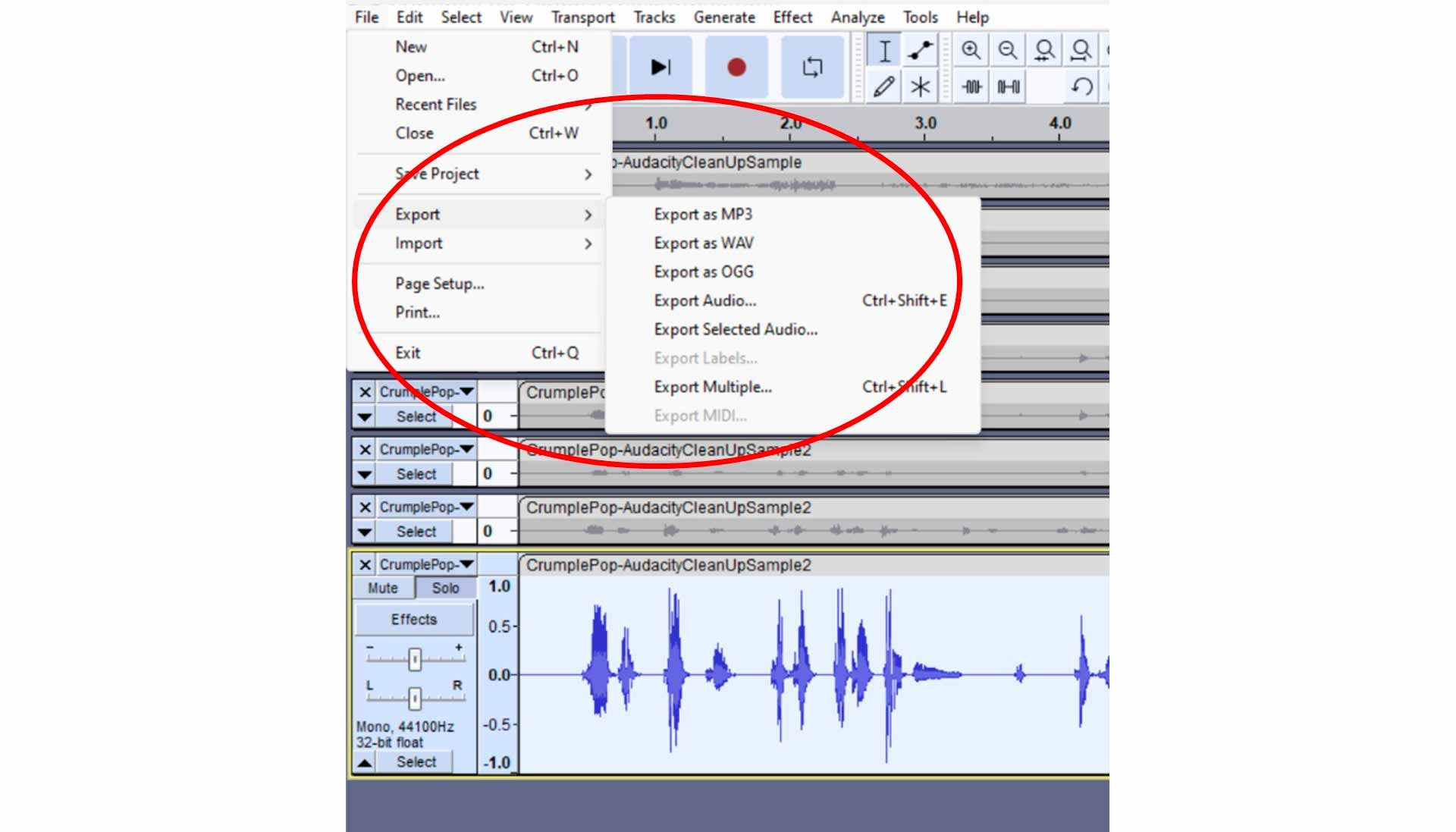If you regularly record sound, one challenge you'll often face is cleaning up your recordings in post-production, i.e., to reduce noise, unwanted silences, and irregular volume dynamics to improve audio quality.
In this post, we'll show you how to clean up your audio using Audacity. Whether for live performances, voice recordings, or background music for an audio or video file, it's easy to improve audio quality with Audacity.
Reasons for Using Audacity for Editing Audio
Audacity is a free, open-source, cross-platform, and versatile editor for audio recordings. With Audacity, you can:
- Work with 16-bit or 24-bit recordings
- Import an audio track and use a range of essential audio editing tools
- Convert files across different formats, e.g., WAV, AIFF, AU, FLAC, and MP3
- Mix and combine audio files
- Work with a variety of platforms, including Windows, Linux, and Mac OS
- Use specialized external plug-ins, e.g., noise reduction plug-ins
While Audacity's features are limited compared with more sophisticated (mostly paid) DAWs, it is capable and easy to use, making it a popular choice with audio enthusiasts and researchers worldwide to improve sound quality.
How to Clean Up Audio Using Audacity
In Audacity, you can remove background noise first by first highlighting a section of the recording without intentional sounds. When you start recording, let microphones capture the “sound of the room” for a few seconds before anyone speaks, as this will make the noise removal process much easier later on. Then, go to Effect > Noise Removal in the menu options and click on 'Get Noise Profile'. Finally, highlight the entire recording from start to end, and once again go to Effect > Noise Removal in the menu options and click 'OK'.
There are many ways to clean up audio—how much noise you're comfortable with and the overall sound you're after will guide your approach. In this post, we'll look at reducing unwanted background noise, removing pops and clicks, trimming silences, and normalizing volume.
-
Import or Make a Copy of the Audio File You're Cleaning Up
With Audacity installed, the first step is to import the audio files that you want to clean up:
- Open Audacity
- Choose File > Import > Audio (shortcut: CTRL + SHIFT + I)
- Find the audio file that you want to clean up and select it
Audacity will open up the file and display its waveform, ready for you to edit.
Note that if you have difficulty importing some file formats, e.g., M4A files, you can convert them using an additional tool such as FFmpeg which can be easily installed in Audacity.

As an alternative, you can make a copy of a file that's already in Audacity and clean up the copy. The easiest way to do this is with the Duplicate command:
- Select the audio file that you want to duplicate
- Choose Edit > Duplicate (Shortcut: CTRL + D)

-
Noise Reduction: Remove Background Noise, Pops, and Clicks
Noise comes in many forms but most often appears as background noise, pops (plosives), and clicks in your recordings. You can either use Audacity's built-in tools or external plug-ins to clean this up.
2.1 Remove Background Noise Using Audacity's Built-In Tools
It's easy to Remove Background Noise in Audacity:
- Find a noise sample, i.e., a section of your audio track that has only background noise—hopefully, you can find something that's a few seconds long to provide a sufficient noise profile; otherwise, find the longest section that you can.
- Select the section—you can do this by placing your cursor at the beginning of the background noise section, clicking the left mouse button, dragging the cursor to the end of the section, and then releasing the mouse button.
- Choose Effect > Noise Removal and Repair > Noise Reduction.
- In the popup box that appears, press the 'Get Noise Profile' button.
- Select the entire track for which you want to remove background noise.
- Again, choose Effects > Noise Removal and Repair > Noise Reduction.
- Fine-tune the parameters for the noise reduction filter, i.e., the level (dB), the sensitivity, and the frequency smoothing bands, or repeat the "Get Noise Profile" step. To help find the correct settings:> Listen to the sound that will be removed by selecting the 'Residue' toggle and clicking 'Preview'.> Listen to the sound that will remain by selecting the 'Reduce' toggle and clicking 'Preview'.
- When you're happy with your chosen parameter settings, select 'OK' (be sure to select the 'Reduce' toggle if you had previously selected the 'Residue' toggle.)

Play back your track. If you've chosen your noise reduction filter parameters well, you should notice an improvement.
For more detailed instructions and helpful hints on the noise reduction effect, check out our guide on how to remove background noise in Audacity.
If you want to remove background noise that's more like a high-frequency hissing sound rather than a more general background or ambient noise, our guide on how to remove hiss in Audacity will help you using a notch filter and other Audacity tools.
-
2.2 Remove Background Noise Using an External Plug-in
As useful as Audacity's built-in noise removal effect is, you may find that you can't get quite the results that you want. In this case, it's worth turning to more sophisticated external audio editing tools that can do a better job.
Let's look at CrumplePop's noise reduction effect, AudioDenoise, which uses advanced AI techniques to create high-quality audio.
AudioDenoise works with a variety of DAWs, including Audacity, and has a free trial that you can take advantage of. It's easy to download and install by following the instructions on CrumplePop's free download page.
It may be worth making a fresh (duplicate) copy of your original file so that you can compare results between AudioDenoise and Audacity's built-in noise reduction. Once AudioDenoise is installed, here's how to use it:
- Select the entire recording of the (duplicate) audio track that you want to clean up.
- Choose Effect > CrumplePop Complete > AudioDenoise Complete (this will appear in Audacity's menu after you follow CrumplePop's installation instructions.)
- The AudioDenoise interface will appear and give you several controls and indicators that you can work with. Usually, all you'll need to do is adjust the 'Strength' control (the large round dial), but you can also tweak the low, medium, and high-frequency noise levels using the three smaller knobs at the bottom of the interface.
- Play around with the controls and use the Preview button to hear your results—once you're happy, click the Apply button.

You probably won't need too much tweaking when you use the AudioDenoise tool, as the AI functionality does a lot of the work in the background. You should get better quality audio using this tool.
-
2.3 Remove Pops and Clicks Using Audacity's Built-in Tools
Rather than constant background noise, a common issue is intermittent pops, clicks, or plosives from your audio tracks, as often occurs with voice recordings. Audacity has a convenient built-in tool for this:
- Select the audio track that you want to remove pops, clicks, or plosives from—the tool will work across the entire file.
- Choose Effect > Noise Removal and Repair > Click Removal.
- In the popup box that appears, set the parameters for Threshold and Max Spike Width, and as with the Noise Reduction tool, you can preview your audio before finalizing.
- When your parameters are set, select 'OK'.

-
2.4 Remove Pops and Clicks Using an External Plug-in
As before, Audacity's built-in Click Removal tool is good, but you can get better results with an external plug-in, so let's try CrumplePop's AI-powered PopRemover tool:
- Install PopRemover just as you did with AudioDenoise (if you downloaded the CrumplePop suite of tools earlier, you won't need to download PopRemover separately.)
- Select the (duplicate) audio track from which you want to remove pops and clicks.
- Choose Effect > CrumplePop Complete > PopRemover Complete (this will appear in Audacity's menu.)
- As with AudioDenoise, the PopRemover interface is easy to use, and you'll usually need to adjust only the 'Strength' control.
- Adjust your settings with the help of the Preview button, and once you're happy, click the Apply button.

-
Cut and Trim Silence
Other than reducing noise, you can improve your audio by removing unwanted silences. Fortunately, this is easy to do in Audacity with its Truncate Silence tool:
- Select the track that you want to remove silences from.
- Choose Effect > Special > Truncate Silence.
- Set your parameters:> You can detect silence by setting its 'Threshold' level and 'Duration', i.e., any sound that's quieter than the silence threshold (e.g., -20 dB), for longer than the max duration (e.g., 0.5 secs), is treated as silence.> You can decide what action to take by selecting 'Truncate Detected Silence' and choosing how long to truncate the detected silences to, e.g., setting this to 0.5 secs means that all detected silences will be truncated to 0.5 secs.
- When you're happy with your settings, select 'Apply'.

For more detailed instructions, including how to cut and trim single or multiple tracks, and how to rearrange tracks, check out our guide on how to cut audio in Audacity.
-
Normalize Audio Levels
While it may seem less obvious, variations in the noise level of your audio play an important role in how it sounds. You can balance out the loudness of your whole track by normalizing it:
- Select the track that you want to normalize.
- Go to the effects menu > Volume and Compression > Normalize.
- Set your parameters:> Check the 'Remove DC offset' box to prevent possible distortion or reduction in headroom (if you're unsure, just keep this checked.)> Set the peak amplitude, i.e., the maximum amplitude that you want to normalize to (NB. This is expressed as a -ve dB level, i.e., dBFS, by default.)> Select whether you want to normalize stereo channels independently or identically.
- When you're happy with your settings, select 'Apply'.

While this will get the job done, there's a lot more to loudness normalization in Audacity—check out our guide on Audacity loudness normalization for more on this important aspect of audio production.
-
Export Audio File
Last, but not least, once you've cleaned up your audio files, you can export to a number of popular formats:
- Choose File > Export > Export Audio.
- Select the file format that you want from the menu.

What it Takes to Get the Best Possible Audio Recording in Audacity
Sound production is both art and science. How you finish your audio depends on your technical approach and your personal preferences. Nevertheless, here are a few guidelines to help you get high-quality audio:
- Use decent equipment, e.g., a good quality microphone, pop filters, interfaces, and cables.
- Pay attention to acoustics, e.g., external disturbances, placement of people (for a voice track), musicians, equipment, and the acoustic properties of your recording space.
- Get the volume levels and dynamics right during recording, i.e., minimize the need for post-production and do a few test recordings before committing a take.
Conclusion
In this post, we've looked at how to remove noise and improve audio quality with Audacity. It's easy to do since Audacity is versatile and capable, and best of all, it's free!
So, if you're looking to clean up your recordings without purchasing a sophisticated DAW, then Audacity, possibly with the help of external plug-ins, may be just what you need.



